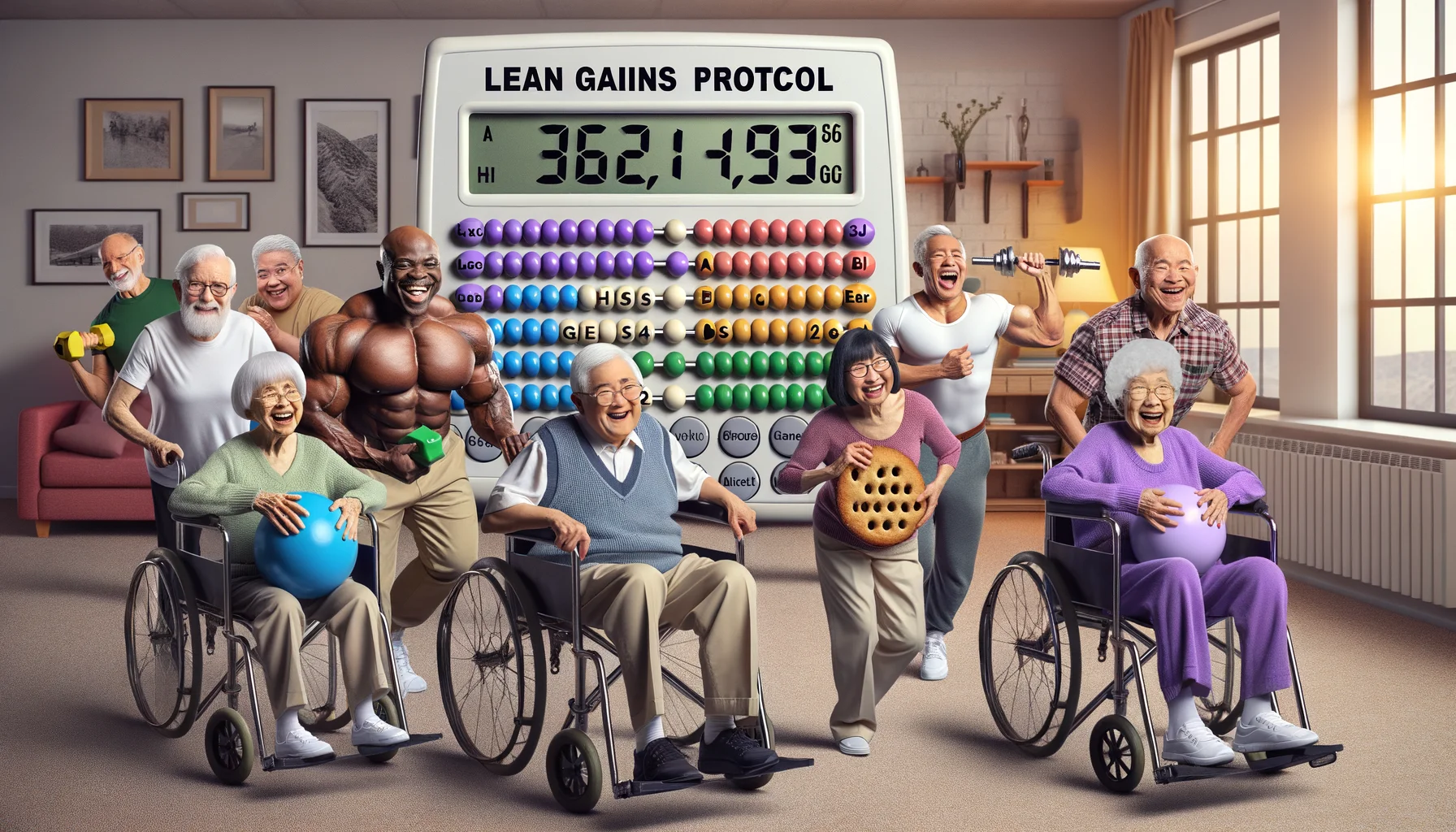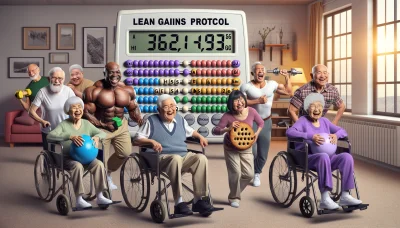Lean gains protocol Quiz
Test Your Knowledge
Question of
Understanding Lean Gains Protocol
What is Lean Gains Protocol?
The Lean Gains Protocol is a revolutionary fitness strategy that has captured the attention of health enthusiasts worldwide. It's a structured approach that combines intermittent fasting with weight training, designed to maximize fat loss while simultaneously promoting muscle growth. This protocol is not just about what you eat, but also when you eat, creating a powerful synergy for body transformation.
Focused on efficiency and effectiveness, the Lean Gains Protocol emphasizes meal timing to align with your workout schedule. Nutrition plays a crucial role here, with macronutrient intake tailored to individual needs and activity levels. The protocol's adaptability makes it suitable for a wide range of individuals aiming to achieve their fitness goals.
The Science Behind Lean Gains
Lean Gains is grounded in scientific research, primarily centering around the benefits of intermittent fasting and resistance training. Fasting periods typically last for 16 hours, followed by an 8-hour eating window. This pattern encourages the body to use stored fat as energy, enhancing weight loss efforts. Resistance training complements this by stimulating muscle growth and improving overall strength.
Intermittent fasting impacts hormone levels, notably increasing human growth hormone (HGH) and improving insulin sensitivity. These hormonal changes are instrumental in promoting lean muscle mass while reducing body fat percentages. The science supports the idea that Lean Gains can be an effective method for achieving a well-defined physique.
Core Principles of Lean Gains
The core principles of Lean Gains revolve around timing, nutrition, and exercise. Adherents must fast for specific periods, consume a balanced diet during feeding windows, and engage in regular strength training sessions. The protocol's structure ensures that calorie intake aligns with energy expenditure for optimal results.
To successfully implement Lean Gains, one must be disciplined in adhering to the fasting schedule and diligent with their dietary choices. Macronutrients need to be carefully balancedproteins remain high, fats are moderated, and carbohydrates are strategically consumed around workouts for fuel and recovery.
Benefits of Lean Gains for Body Composition
The benefits of the Lean Gains Protocol on body composition are significant and multifaceted. It's not just about losing weight; it's about sculpting a leaner, more muscular physique. Participants often report increased muscle definition alongside reduced body fat percentagesa coveted combination in fitness circles.
Another advantage is the potential improvement in overall body composition metrics such as BMI (Body Mass Index) and waist-to-hip ratios. These improvements can contribute to better physical health outcomes and an enhanced aesthetic appearance.
Muscle Growth and Fat Loss
Muscle growth and fat loss are two pillars of the Lean Gains approach. The strategic combination of fasting and resistance training triggers what's known as recompositionlosing fat while gaining muscle simultaneously. This is especially appealing because it challenges the traditional belief that one cannot achieve both at the same time.
By manipulating energy intake around workout times, Lean Gains maximizes nutrient uptake by muscles, which aids in their growth and repair while minimizing fat storage. Consistency with this approach leads to steady progress towards a leaner physique without sacrificing muscle mass.
Improved Metabolic Health
Beyond aesthetics, the Lean Gains Protocol has been shown to offer substantial benefits for metabolic health. Intermittent fasting can lead to improved blood sugar control, lower cholesterol levels, and better regulation of metabolic hormones like insulin.
- Enhanced Insulin Sensitivity: Regular fasting periods may decrease insulin resistance, reducing the risk of type 2 diabetes.
- Better Lipid Profiles: Positive changes in cholesterol levels can contribute to cardiovascular health.
- Inflammation Reduction: Some research suggests that intermittent fasting can lower inflammation markers in the body.
- Amped Up Fat Oxidation: Fasting states encourage the body to burn stored fat for fuel instead of glucose from recent meals.
Common Misconceptions About Lean Gains
Misconceptions about Lean Gains abound, leading some to underestimate its complexity or dismiss its effectiveness altogether. One common myth is that it's solely about fasting or that any form of eating restriction will yield similar resultswhich is simply not true.
The protocol isn't just about skipping meals; it requires precise nutritional planning and dedicated exercise regimens for true success. It's important for those interested in this approach to understand these nuances before embarking on their journey.
Separating Myths from Facts
To realize the full potential of Lean Gains, debunking myths is essential. For instance, some believe it causes muscle loss due to fasting; however, when done correctly with adequate protein intake and resistance training, muscle preservation is entirely possible.
Realistic Expectations and Outcomes
Last but not least, setting realistic expectations is crucial when adopting the Lean Gains Protocol. Transformations take time and consistencyovernight success stories are rare if not non-existent. Understanding this helps set achievable goals while maintaining motivation throughout the process.
Essential Components of Lean Gains Diet
The Lean Gains Diet is a game-changer for fitness enthusiasts aiming to build muscle and lose fat. It's a strategic approach that combines the science of nutrition with the art of body sculpting. This diet isn't just about eating less; it's about eating smart, timing your meals right, and choosing quality foods that fuel your body effectively.
Embarking on the Lean Gains journey means understanding the key components that make this diet so effective. You'll need to grasp the importance of macronutrient ratios, meal timing, and food quality. Each element plays a pivotal role in helping you achieve those chiseled abs and lean muscle mass.
Macronutrient Ratios for Optimal Results
Macronutrient ratios are the backbone of the Lean Gains Diet. They are essential for providing your body with the right balance of proteins, carbohydrates, and fats. Getting these ratios right can mean the difference between making gains or hitting a plateau.
Calculating Your Macros is crucial in tailoring your diet to your specific needs. It involves determining how much protein, carbs, and fats you need based on your body composition and fitness goals. These macronutrients fuel your workouts and recovery, making them non-negotiable for lean gains.
Adjusting Macros for Training Days is equally important. On days you hit the gym, you'll need more energy - meaning more carbs and possibly more calories overall. On rest days, scaling back on carbs can help manage energy balance and aid in fat loss.
Importance of Meal Timing and Frequency
Meal timing can be just as crucial as what you eat when it comes to building muscle without gaining excess fat. The Lean Gains Diet emphasizes not only nutrient composition but also when those nutrients are consumed throughout the day.
- Intermittent Fasting and Feeding Windows: This component involves cycling between periods of fasting and eating. It helps regulate blood sugar levels, improves metabolic health, and supports fat loss while preserving muscle mass.
- Pre- and Post-Workout Nutrition: Consuming the right nutrients before and after exercise can enhance performance, promote recovery, and ensure that your body has the necessary building blocks for muscle growth.
Food Choices and Quality in Lean Gains
Your food choices on the Lean Gains Diet should focus on nutritional density - selecting foods packed with vitamins, minerals, and other essential nutrients. High-quality food choices lead to better health outcomes and more effective body composition changes.
Whole Foods vs. Processed Foods: Emphasizing whole foods over processed options ensures you're getting unrefined nutrients without unnecessary additives or preservatives. Whole foods provide cleaner energy sources for your body to utilize during workouts and recovery.
Organic vs. Non-Organic: While organic food is often touted for its lack of pesticides and potential health benefits, what's most important is consuming a variety of nutrient-dense foods whether they're organic or not. Prioritize quality but don't let perfect be the enemy of good when selecting your groceries.
Workout Strategies for Maximizing Lean Gains
Resistance Training for Muscle Hypertrophy
Muscle hypertrophy is the golden ticket to maximizing lean gains, and resistance training is your VIP pass. By challenging your muscles with weights, you create micro-tears that, when repaired, lead to muscle growth. The key is consistency and working all major muscle groups for a well-rounded physique.
Choosing the right exercises can make or break your muscle-building journey. Compound movements such as squats, deadlifts, and bench presses should be the cornerstone of your program. They engage multiple muscle groups, triggering more significant growth hormone release and ensuring comprehensive development.
Structuring Your Workout Routine
A well-structured workout routine balances volume, intensity, and frequency to maximize hypertrophy while minimizing the risk of overtraining. Splitting your workout by muscle groups allows targeted training and adequate recovery time. For instance, you might hit chest and triceps on Mondays, back and biceps on Wednesdays, and legs on Fridays.
To keep advancing in your fitness journey, it's crucial to vary your routine every 4-6 weeks. This variation prevents plateaus by challenging the muscles in new wayswhether through different exercises, rep ranges, or rest periodskeeping the gains coming.
Progressive Overload Principle
The progressive overload principle is non-negotiable for continued improvement. Gradually increasing the weight or resistance forces the muscles to adapt by growing stronger and larger. Tracking your workouts ensures that you're consistently upping the ante.
Besides just adding weight, progressive overload can also be achieved by increasing reps or sets or reducing rest times between sets. The goal is to push beyond comfort zones while maintaining proper form to stimulate muscle adaptation without causing injury.
Incorporating Cardiovascular Exercise
Cardiovascular exercise isn't just for endurance athletesit's a critical component of any well-rounded fitness regimen aimed at maximizing lean gains. While too much cardio can hinder muscle growth due to excess calorie expenditure, a balanced approach supports heart health and fat loss.
- Maintain Balance: Incorporate cardio without compromising muscle gain by limiting sessions and focusing on intensity.
- Choose Wisely: Opt for cardio forms that complement strength training goals such as cycling or rowing over long-distance running.
- Fuel Appropriately: Ensure adequate calorie intake to fuel both cardio and resistance training efforts.
- Time It Right: Schedule cardio after lifting weights or on separate days to preserve energy for heavy lifts.
- Monitor Progress: Keep an eye on body composition changes to ensure cardio isn't undermining muscle building.
High-Intensity Interval Training (HIIT)
High-Intensity Interval Training (HIIT) has emerged as a game-changer in the fitness world. By alternating short bursts of intense activity with brief recovery periods, HIIT maximizes calorie burn within a shorter durationideal for those aiming to maintain lean mass while improving cardiovascular health.
The beauty of HIIT lies in its versatility; it can be tailored using various modalities like sprinting, cycling, or plyometrics. This flexibility makes it easy to integrate into any workout schedule without overtaxing the body's recovery capabilities.
Steady-State Cardio and Fat Oxidation
In contrast to HIIT, steady-state cardio involves maintaining a consistent pace over a longer periodthink jogging or swimming laps. This type of cardio promotes fat oxidation and can be beneficial when strategically implemented into a workout regimen focused on lean gains.
To capitalize on steady-state cardio's benefits without sacrificing hard-earned muscle mass, limit sessions to 20-30 minutes and consider doing them on non-resistance training days. This approach helps maintain a caloric deficit conducive to fat loss while preserving muscle tissue integrity.
Recovery and Rest Days
Recovery isn't merely an intermission between workouts; it's when the magic happensmuscle repair and growth. Ignoring rest can lead to overtraining syndrome which halts progress dead in its tracks. Therefore, integrating deliberate rest days is vital for sustained improvement and health maintenance.
Importance of Sleep for Muscle Recovery
Sleep is perhaps the most underrated tool in your bodybuilding arsenal. During sleep, growth hormone levels peak facilitating tissue repair and growth. Aim for 7-9 hours of quality sleep per night as part of your recovery strategya non-negotiable practice for anyone serious about gaining lean muscle mass.
Active Recovery Techniques
Active recovery techniques such as light exercise or mobility work can aid in reducing soreness post-workout while enhancing blood flow to recovering musclesa win-win situation! Incorporate activities such as walking or yoga on off days which can also help in managing stress levelsan often-overlooked aspect of recovery.
Tracking Progress and Making Adjustments
Setting Realistic Goals and Milestones
Embarking on a fitness journey begins with setting attainable goals that propel you forward. Establishing clear, realistic milestones acts as a roadmap, guiding your efforts and keeping you focused. It's crucial to tailor these goals to your personal capabilities and lifestyle to ensure they're achievable and sustainable.
Milestones should be broken down into short-term and long-term categories, each with its own purpose. Short-term goals provide immediate challenges and quick wins, keeping motivation high, while long-term goals offer a vision of what you're striving for in the bigger picturethese are the dreams that fuel your day-to-day grind!
Short-Term vs. Long-Term Goals
Short-term goals act as stepping stones to your ultimate objective, often providing a sense of accomplishment that spurs continued effort. They can be weekly or monthly targets that are specific and time-bound. Long-term goals, on the other hand, might span several months to a year and require sustained effort; they represent the culmination of all your hard work.
Measuring Progress Beyond the Scale
The scale isn't the only barometer of success. It's essential to measure progress in various ways, such as body measurements, fitness levels, energy, and overall health. This multi-faceted approach provides a comprehensive view of your achievements and can keep you inspired even when numerical weight doesn't budge.
Adjusting Diet and Exercise Based on Results
Your body is an adaptive machine, which means that over time it responds to diet and exercise regimes differently. To continue making strides in your fitness journey, it's vital to tweak your approach based on the results you're seeingor not seeing. Monitoring changes closely will inform when it's time for adjustment.
When to Increase Caloric Intake
Increase caloric intake if you find yourself losing too much weight too quickly or feeling consistently fatigued. More calories might be necessary to fuel workouts effectively or to ensure you're getting enough nutrients for muscle recovery and growth.
Modifying Workouts for Plateaus
- Varying your exercises can shock your muscles into growth and overcome plateaus.
- Increase intensity or volume gradually to challenge your body without risking injury.
- Incorporate rest days strategically to allow for recoverya key component in progress.
- Seek professional advice if self-adjustments do not yield results after a reasonable period.
Importance of Consistency and Patience
The true secret behind any successful fitness regimen is unwavering consistency paired with patience. It's about showing up day after day, even when progress seems slow. These qualities lay the foundation for long-lasting change and prevent the discouragement that can come from unrealistic expectations.
Staying Motivated Through Plateaus
Plateaus are inevitable but surmountable with perseverance. Staying motivated during these times requires focusing on non-scale victories like improved stamina or strength gains. Remembering why you started this journey can also reignite your drive during tough times.
Celebrating Small Victories
Celebrate every achievement, no matter how small it may seem! Every milestone reached is proof of your dedicationwhether it's fitting into a smaller size, adding an extra mile to your run, or simply choosing a healthy meal over fast food. These triumphs are what build momentum towards larger goals.
Overcoming Challenges in Lean Gains Protocol
Dealing with Hunger and Cravings
Managing Hunger During Fasting Periods
Conquering hunger during fasting periods is a true test of willpower and strategy. To master this, stay hydrated! Water can help you feel full and keep cravings at bay. Incorporate coffee or tea, which are not only zero-calorie beverages but also natural appetite suppressants. Remember, consistency is key; your body will adapt to the new eating schedule over time, making it easier to manage hunger.
Healthy Snack Options for Cravings
When cravings hit, it's essential to be prepared with healthy snack options. Reach for snacks packed with protein and fiber, such as Greek yogurt or a handful of nuts, to keep you satiated. Consider veggies with hummus or a piece of fruit for a nutrient-rich choice that satisfies without derailing your progress. It's all about smart substitutions that align with the Lean Gains approach.
Balancing Social Life with Diet Protocol
Eating Out and Social Events
Eating out doesn't have to mean ditching your diet protocol. Look for lean proteins and vegetables on the menu, which are staples of the Lean Gains diet. Don't hesitate to ask for customizationsrestaurants are typically accommodating to dietary requests. Plan ahead by adjusting your eating window or saving extra calories for social events, ensuring you enjoy without guilt!
Alcohol Consumption and Its Effects
Let's talk about alcoholit's a social lubricant but can be tricky when following Lean Gains. Alcohol contains empty calories and may lead to poor food choices. If you choose to drink, opt for lower-calorie options like light beer or a glass of wine, and limit your intake. Remember that moderation is crucial; enjoy responsibly while sticking to your goals.
Traveling and Maintaining Lean Gains Protocol
Staying on Track While on the Road
Maintaining the Lean Gains protocol while traveling can seem daunting, but it's totally doable! Pack portable snacks like protein bars or mixed nuts to avoid unhealthy temptations. Research local food options that fit within your diet plan beforehand, so you're never caught off guard. Embrace flexibility; if your eating window shifts slightly while traveling, it's okayadapt and stay committed!
Quick and Effective Hotel Workouts
You don't need a gym to maintain your fitness routine on the roadhotel workouts can be incredibly effective! Focus on bodyweight exercises such as push-ups, squats, and lunges that can be done anywhere. Utilize hotel furniture for elevated exercises or improvised weights. Consistency is vital; even a short workout maintains momentum until you're back in your usual routine.
- Stay Hydrated: Drink plenty of water throughout the day to reduce hunger pangs.
- Plan Ahead: Know restaurant menus in advance to make smart choices easily.
- Pack Smart Snacks: Always have healthy snacks on hand during travel.
- Moderate Alcohol Intake: Choose lighter drinks and limit consumption.
- Fitness Flexibility: Be ready to adapt your workout routine when away from home.
- Mindful Eating: Pay attention to what you eat; don't let distractions lead to overeating.
- Educate Yourself: Learn about calorie content and nutrition to make informed decisions.
- Social Support: Surround yourself with friends who support your fitness goals.
Advanced Techniques for Experienced Practitioners
Carb Cycling for Enhanced Fat Loss
Carb cycling is a powerhouse technique that oscillates carbohydrate intake to maximize fat loss while preserving muscle mass. By alternating between high-carb and low-carb days, the body's metabolism becomes more efficient. This dynamic approach keeps your body guessing, preventing weight loss plateaus and enhancing fat oxidation.
For athletes and bodybuilders looking to shed fat without sacrificing performance, carb cycling offers a strategic solution. It supports intense workouts on high-carb days and promotes fat burning on low-carb days. The key is to align high-carb days with heavy training sessions for fuel and recovery.
Implementing Carb Cycling in Your Diet
Integrating carb cycling into your diet requires careful planning and attention to detail. Start by determining your daily caloric needs and designate specific days for high, medium, and low carbohydrate intake. Tracking your macros is essential to ensure you're hitting the right numbers.
Maintaining a balanced diet while carb cycling is crucial. Focus on whole food sources like vegetables, lean proteins, and complex carbs. Remember, consistency is vital erratic carb consumption can derail progress.
Benefits of Carb Cycling for Lean Gains
Carb cycling isn't just about fat loss; it's also a potent strategy for making lean gains. By fueling the muscles with carbohydrates during high-intensity workouts, you can push harder and stimulate more muscle growth. Meanwhile, low-carb days help minimize fat gain.
The psychological benefits are just as impressive. Carb cycling allows for greater dietary flexibility, reducing the mental strain of strict dieting. It's a sustainable approach that can lead to long-term success in achieving a chiseled physique.
Supplementation to Support Lean Gains
The right supplements can be game-changers when it comes to building muscle and achieving lean gains. They fill nutritional gaps, enhance recovery, and improve performance when used correctly. However, it's essential to prioritize whole foods first and use supplements as an adjunct to a well-rounded diet.
Selecting high-quality supplements is paramount. Look for third-party testing and certification to ensure purity and potency. Supplements are not one-size-fits-all; tailor your stack to your individual needs and goals.
Essential Supplements for Muscle Growth
- *Whey Protein: Fast-absorbing protein that aids in muscle repair post-workout. *Creatine Monohydrate: Increases strength, power output, and muscle volume. *Branched-Chain Amino Acids (BCAAs): Promote muscle protein synthesis and reduce exercise-induced muscle damage. *Omega-3 Fatty Acids: Anti-inflammatory properties support recovery and joint health. *Vitamin D: Essential for bone health and immune function; often deficient in athletes. *Magnesium: Involved in over 300 biochemical reactions; supports muscle function and recovery. *Beta-Alanine: Buffers lactic acid, enhancing endurance during high-intensity exercise. *Caffeine: Boosts focus and energy levels; can enhance performance when timed correctly.
Timing Your Supplements for Optimal Absorption
The timing of supplement intake can significantly impact their effectiveness. For instance, whey protein is most beneficial post-workout when muscles are primed for repair. Creatine can be taken pre or post-workout for performance enhancement or recovery support.
Fat-soluble vitamins like Vitamin D are best taken with meals containing fats to improve absorption. Paying attention to these details ensures you get the most out of your supplementation efforts.
Deloading and Strategic Breaks from Dieting
Deloading in training involves reducing workout volume or intensity temporarily to allow the body to recover fully from the stresses of constant heavy lifting. This practice helps prevent overtraining, reduces injury risk, and prepares the body for future gains by allowing full recovery.
Incorporating deload weeks into your routine every 4-6 weeks can lead to improved performance in the long run. Listen to your body's signals fatigue, plateaued progress, or decreased motivation may indicate it's time for a deload phase.
The Role of Deloading in Muscle Building
A proper deload week encourages muscle repair without completely stopping physical activity. It involves scaling back weights or workout frequency but maintains movement patterns to preserve neuromuscular adaptations.
This strategic break allows tendons, ligaments, and joints time to heal while also giving the central nervous system (CNS) a rest from heavy stimuli. As a result, you'll return stronger both mentally and physically.
Planning Diet Breaks for Metabolic Reset
Diet breaks are planned interruptions in calorie restriction that offer similar benefits as deloading does for training. They help reset hunger hormones like leptin and ghrelin, preventing metabolic slowdown associated with prolonged calorie deficits.
Scheduling regular diet breaks not only aids in physiological regulation but also provides psychological relief from strict diet adherence. These breaks should be structured typically lasting 1-2 weeks before returning back to a calorie-restricted state aimed at fat loss or lean mass building.
Integrating Lean Gains with Overall Lifestyle
Managing Stress for Optimal Hormonal Balance
It's crucial to manage stress effectively to maintain hormonal balance conducive to lean gains. Chronic stress wreaks havoc on your body, disrupting the delicate equilibrium needed for muscle growth and fat loss. Implementing daily stress-reducing activities can significantly enhance your body's anabolic environment.
Adopting stress reduction techniques such as meditation, deep breathing exercises, or even just taking a leisurely walk can make a world of difference. These practices are not only rejuvenating but also empower you to handle life's demands without compromising your fitness goals.
Stress Reduction Techniques
- Meditation: Dedicate time each day to mindfulness and mental clarity.
- Physical Activity: Engage in activities like yoga or tai chi that promote both physical and mental well-being.
- Social Interaction: Spend quality time with friends and family to foster positive relationships and reduce stress levels.
Impact of Cortisol on Muscle Growth and Fat Storage
Cortisol, often called the 'stress hormone,' can be a friend or foe in your quest for a lean physique. While its essential for health, too much cortisol can lead to increased fat storage, particularly around the midsection, and can negatively impact muscle growth by breaking down muscle tissue.
To combat the adverse effects of cortisol, focus on stress management and ensure adequate nutrient intake. Balancing macronutrients and maintaining stable blood sugar levels are pivotal in mitigating cortisol spikes throughout the day.
Importance of Sleep in the Lean Gains Protocol
Sleep is a non-negotiable aspect of any successful lean gains strategy. Its during deep sleep that our bodies undergo most of their repair and recovery processes essential for muscle growth. Skimping on sleep can derail progress faster than any workout routine can compensate for.
Aiming for 7-9 hours of quality sleep per night should be a cornerstone of your lifestyle. It's not just quantity but also quality that countsdeep, restorative sleep is what truly aids in recovery and growth.
Sleep Hygiene Practices
Promoting good sleep hygiene involves establishing a regular bedtime routine, creating an environment conducive to rest, and avoiding stimulants close to bedtime. These practices help signal to your body that it's time to wind down and prepare for restful sleep.
How Sleep Affects Muscle Recovery and Growth
During sleep, growth hormone levels peak, facilitating muscle repair and growth. This anabolic state allows the body to build lean muscle efficiently. Lack of sleep disrupts this process, potentially leading to overtraining symptoms and hindering performance gains.
Continuous Learning and Adaptation
The fitness landscape is constantly evolving with new research shedding light on optimal strategies for achieving lean gains. Keeping abreast with current studies helps you refine your approach and avoid stagnation.
Incorporating evidence-based practices into your routine ensures that you're leveraging cutting-edge knowledge for maximum results. Always remain open-minded and ready to tweak your protocol based on emerging scientific insights.
Staying Informed on Latest Research
Whether its through reading scientific journals, following reputable fitness professionals online, or attending seminars, staying informed is key. This commitment to learning keeps you at the forefront of nutritional strategies and workout methodologies that can amplify your results.
Adapting Protocol to Personal Biofeedback
Your body provides constant feedback; listening closely allows you to tailor your approach for personal optimization. Pay attention to signs such as energy levels, strength performance, mood fluctuations, and overall well-being as indicators of whether your current protocol is working or needs adjustment.












